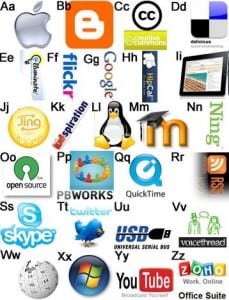 I’ve been promoting e-teaching as a partner to e-learning. A colleague shared a paper which referred to e-teaching and I thought they’d beaten me to it, but the authors opted for Digital Practitioner. At seven syllables a time, I don’t think it’s going to catch on.
I’ve been promoting e-teaching as a partner to e-learning. A colleague shared a paper which referred to e-teaching and I thought they’d beaten me to it, but the authors opted for Digital Practitioner. At seven syllables a time, I don’t think it’s going to catch on.
Being an e-teacher is part of the wider conversation about online identity.
On March 28th I asked ‘When it comes to online ‘tutoring’ what should we be called?’ The term e-learning has become part of the vocabulary of education but e-lecturer is less common.
Who are we online? Teacher, Tutor, Trainer. Lecturer. Facilitator. Moderator. Instructional Designer. Just passing through…
We should bring back the ‘e’ as in e-learning, e-resources. e-literature. e-teaching, e-practice. The e’s have rhythm. e-ducation. e-scholarship.
Research suggests there are no clear benefits to educational technology; any difference made relates to the environment as much as the machine. This runs contrary to the rhetorical promise of ‘e-learning’ which mostly ignores the role of teaching. Recent literature has called for greater attention to educational design – as if that will make a difference. I hope it will. I still believe in the VLE.
I also believe in promoting the role of the e-teacher. Learning online is no easy, cost cutting option. An authentic experience takes time to build; it requires community, through interaction. My ABC model of Activity Based Content uses collaborative tools like wikis, blogs and discussion boards. There’s an absence of powerpoint. Learning online is tough. The loneliness of the long distance teacher/learner has to be experienced to be believed. I’m not sure you can teach online if you haven’t learned there. Which comes back to identity. To be an e-teacher is a skill. Subject specialism isn’t enough. You have to be digitally literate as well and this part is often missing. The gap between SEDA and ALT is more like a chasm.
VLE make great content containers. While teaching has moved on from behaviourist pedagogy, the VLE is still primarily used to support a transmission model of education. Recent online ‘training’ sessions with Blackboard Collaborate reinforce the dominance of the active teacher/passive recipient dynamic.
Looking back, VLE were embedded into university systems and staff told to get on with it. I remember. I was there. The advantage of being er…um….a little more mature… is the benefit of hindsight. There’s been insufficient attention paid to the reality of teaching online. Focus has been on technology and students. Now the time has come to privilege the teaching. The status of the e-teacher needs raising; it’s e-lementary and e-ssential to put teaching first.
—————————————————————————————————————————————————–
Image from https://sd36edtechlead.wikispaces.com/March+2
—————————————————————————————————————————————————–
